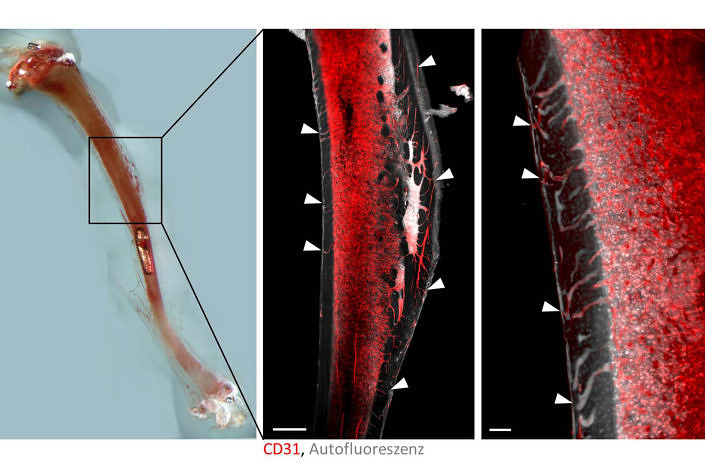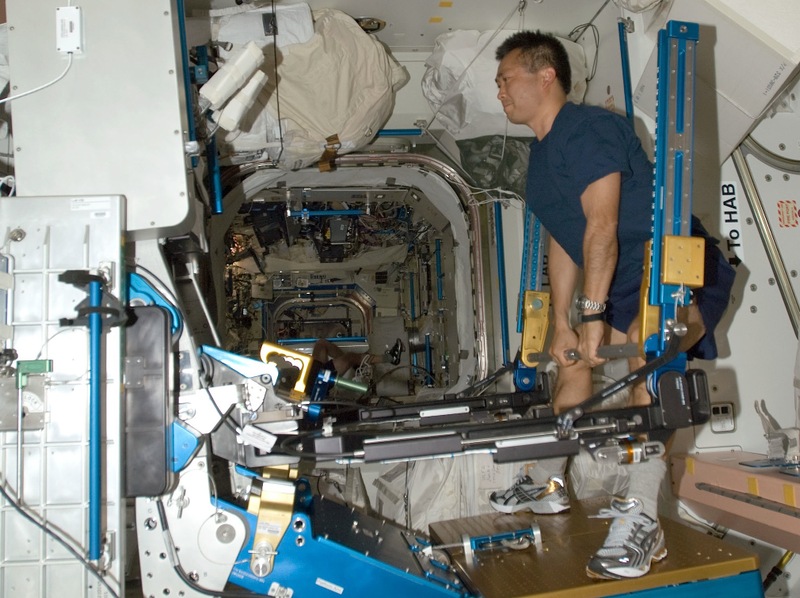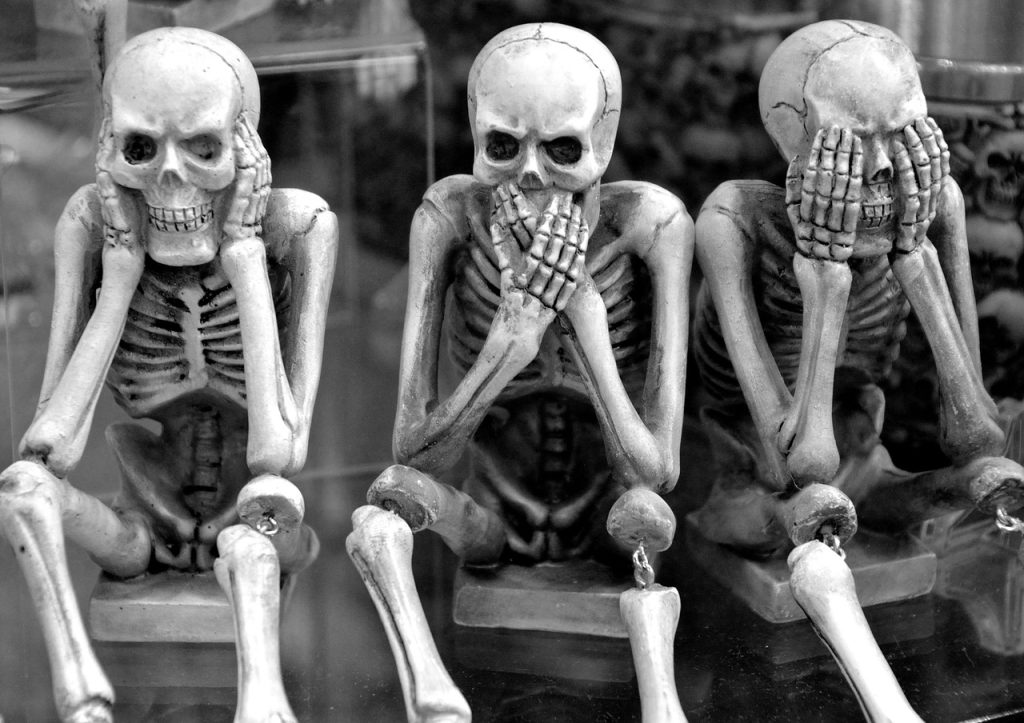An astronaut can expect to lose about 0.5-1.5% of their bone density per month in space (1). That’s how much a post-menopausal woman might lose in 1 whole year, and it would take a whole decade for a man aged 40-60 to lose so much bone. In other words, a fit and healthy astronaut loses bone at a rate of x12 faster than a post-menopausal woman, and x100 faster than a similar aged man! Let’s investigate why this happens, and why studying astronauts’ bones can help to guide us in taking care of our bones here on Earth.
Bones are alive and adaptable
Your bones are alive. We don’t usually think of bones in this way, but they are in a constant state of change. There is an ongoing cycle of breakdown (with minerals being reabsorbed into the body) and building up (with new bone created). Teams of cells act like construction workers (osteoblasts) – building new bone. While other cells act like a demolition crew (osteoclasts) – breaking down damaged, old or unused bone.
The bones act as a nursery for new cells – producing new blood cells and immune cells. The bones store vast amounts of energy and key minerals (such as calcium, which is essential for the function of the heart, muscles and nerves). We tap into this supply when other organs and tissues in the body demand it.
Famously, bones provide us with protection. They make up our skeleton, supporting the body and acting as levers to allow movement.
Bones are interwoven with blood vessels and nerves (2). The amount of blood flowing through your bones at any moment in time is about twice that which flows through your skin (2). We know how adaptable the skin is – how calluses form on our hands or how it heals in response to injury.
Bones are just as alive and vibrant as skin and muscle. The bone environment is like an ecosystem – receiving nutrients and sending minerals elsewhere in the blood; spawning new cells that travel throughout the body; occupied by teams of cells that allow adaptation and healing.

No forces = bones become weaker
Bones, like all living things, respond and adapt to the demands placed upon them. To explore how bones adapt, let’s return to orbit.
With no gravity in space, the bodies of astronauts do not experience any external forces. An astronaut could lift a table just as easily as they could a feather. There is little to no demand for the bones to support their bodies and transfer forces. It is this lack of force running through the bones that causes the bone loss associated with being in space. The body, in all its wisdom, realises that there is no need to maintain strong, dense bones. Why would the body waste resources maintaining strong bones when there is no demand for them?
This adaptation takes place quickly and efficiently. The rate of bone density loss is greatest early in space flight and eases off as time goes on (3) – perhaps as the bone density reaches an ideal level for their new gravity-free environment.
Re-introduce forces = bones regain strength
Thankfully for any astronaut who has been in orbit, the process reverses when they return to Earth – their bones gradually become denser and stronger (3). This rebuilding period takes longer than the breaking-down process (this seems to be true for many things in life – physical, mental, etc.). It can take months or years for the bone to regain its former density, depending on how long the mission was.
Strengthening of the bones, just like their breakdown, is driven by the environment and the forces the bones are exposed to each day. Even just standing up here on Earth (against the forces of gravity) results in forces flowing through the skeleton – stimulating the living bones and informing them of what is expected of them.
Improving Bone Strength
If prolonged exposure to reduced forces results in bone loss, then it would make sense that adding extra forces would build bone, right? That’s exactly what we see.
Lifting weights is associated with stronger bones and introducing weight-training can be an effective way to deal with conditions such as osteoporosis. In post-menopausal women (who tend to suffer significant bone density loss each year), a good strengthening programme can be powerful in reducing bone loss, and for some it can even result in a gain in bone density (4, 5). In fact, NASA installed a device to allow astronauts to lift heavy weights in space. This device, while not preventing bone loss, has helped to drastically reduce it (1).
While weight training seems invaluable for keeping our bones strong, there’s a lot to be said for walking regularly. Multiple times your body weight travels through the bones and joints of your hip (8) and your back (9) with every step you take. This increases with speed. So regular walking (or running if you can) is key for healthy bones.
Low-impact exercise such as pilates and yoga do not protect us from bone density loss (6). The best programmes involve lifting weights that are challenging, are performed at least twice per week and are continued in the long run (4).
Interestingly, our hunter gatherer ancestors seemed to have stronger, denser bones compared to our ancestors who were agriculturalists (7). The key reason for this is believed to be due to how active and mobile they were – exposing their bones to regular impact and forces.

Healthy body = Healthy bones
As mentioned previously, the bones act like an ecosystem. If we consider the blood vessels to be like rivers and streams – transporting nutrients, energy and minerals to and from bones – then it makes sense that what happens upstream will affect bone health. Just like an unhealthy river will result in poorer health for the land that it supports, unhealthy bodies do not support bone health. Conditions affecting the blood supply, such as heart conditions and high blood pressure, are linked to poor bone health. As are conditions affecting metabolic health – such as diabetes.
No tissues in the body stand alone, they are part of the large and complex living organism that we are. The great thing about this is that by adopting healthy habits, not only do we improve our health and well-being, we can be sure we are having a positive effect on our bones.
All the more reason to get more active. All the more reason to take care of your health. None of this means that you need to lead flawlessly healthy lives. What it does mean is that consistent, regular healthy habits, such as exercise, are priceless in taking care of our bones.
Video: Weightlifting on the International Space Station With Astronaut Doug Wheelock
Video: Modern bones vs our ancestors
References:
- Ackerman, K.E., Popp, K.L. and Bouxsein, M.L., 2021. Rocket science: what spaceflight can tell us about skeletal health on Earth. British Journal of Sports Medicine, 55(21), pp.1182-1183.
- Marenzana, M. and Arnett, T.R., 2013. The key role of the blood supply to bone. Bone research, 1(1), pp.203-215.
- Stavnichuk, M., Mikolajewicz, N., Corlett, T., Morris, M. and Komarova, S.V., 2020. A systematic review and meta-analysis of bone loss in space travelers. npj Microgravity, 6(1), p.13.
- Rhodes, E.C., Martin, A.D., Taunton, J.E., Donnelly, M., Warren, J. and Elliot, J., 2000. Effects of one year of resistance training on the relation between muscular strength and bone density in elderly women. British journal of sports medicine, 34(1), pp.18-22.
- Kistler-Fischbacher, M., Weeks, B.K. and Beck, B.R., 2021. The effect of exercise intensity on bone in postmenopausal women (part 2): a meta-analysis. Bone, 143, p.115697.
- Fernández-Rodríguez, R., Alvarez-Bueno, C., Reina-Gutiérrez, S., Torres-Costoso, A., Nunez de Arenas-Arroyo, S. and Martínez-Vizcaíno, V., 2021. Effectiveness of Pilates and Yoga to improve bone density in adult women: A systematic review and meta-analysis. PloS one, 16(5), p.e0251391.
- Ryan, T.M. and Shaw, C.N., 2015. Gracility of the modern Homo sapiens skeleton is the result of decreased biomechanical loading. Proceedings of the National Academy of Sciences, 112(2), pp.372-377.
- Bergmann, G., Deuretzbacher, G., Heller, M., Graichen, F., Rohlmann, A., Strauss, J. and Duda, G.N., 2001. Hip contact forces and gait patterns from routine activities. Journal of biomechanics, 34(7), pp.859-871.
- Arshad, R., Angelini, L., Zander, T., Di Puccio, F., El-Rich, M. and Schmidt, H., 2018. Spinal loads and trunk muscles forces during level walking–A combined in vivo and in silico study on six subjects. Journal of Biomechanics, 70, pp.113-123.
Images:
Title Image: Image by Paul Brennan from Pixabay
Blood supply to mouse tibia: UDE/Matthias Gunzer, Anika Grüneboom
ARED – astronaut lifting weights: International Space Station/Japan Aerospace Exploration Agency astronaut Koichi Wakata


Pingback: Strength Training for Health: A Physiotherapist's Perspective -